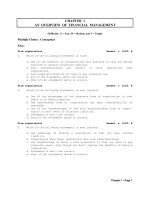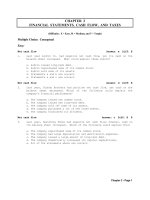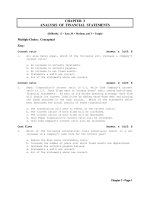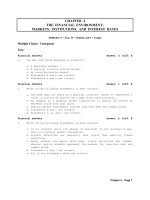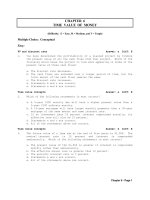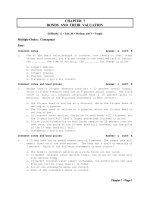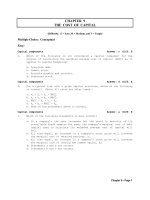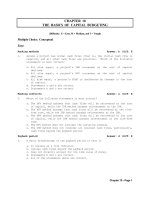Test bank accounting management 11e chapter 01 THE ACCOUNTANTS ROLE IN THE ORGANIZATION
Bạn đang xem bản rút gọn của tài liệu. Xem và tải ngay bản đầy đủ của tài liệu tại đây (126 KB, 14 trang )
CHAPTER 1
THE ACCOUNTANT’S ROLE IN THE
ORGANIZATION
LEARNING OBJECTIVES
1.
Describe how cost accounting supports management accounting and financial
accounting
2. Understand how management accountants affect strategic decisions
3.
Distinguish between the planning and control decisions of managers
4. Distinguish among the problem-solving, scorekeeping, and attention-directing roles of
management accountants
5. Identify four themes managers need to consider for attaining success
6. Describe the set of business functions in the value chain
7.
Describe three ways management accountants support managers
8. Understand how management accounting fits into an organization’s structure
9. Understand what professional ethics mean to management accountants
CHAPTER OVERVIEW
Chapter 1 is an important foundation chapter. The theme of the text, Cost Accounting: A
Managerial Emphasis, 11/E, is the major role that accounting plays in management decision
making. Accounting provides information managers need when making decisions. Financial
accounting provides information to external managers while modern cost accounting yields
insights into what managers and accountants do within an organization. Management accountants
provide financial and nonfinancial information to help managers decide how best to deal with
challenges and opportunities.
Management accounting is successful when it provides information that improves managers’
strategic, planning, and control decisions. The use of accounting in the planning and control
process is introduced and highlighted in the text example.
A framework for understanding management accounting systems in providing managers
information is developed in the chapter. The goals, roles, activities, and guidelines of
management accounting systems are described through understanding what managers do.
An introduction and discussion of professional ethics including standards of ethical conduct for
management accountants is presented.
2
Chapter 1
CHAPTER OUTLINE
Learning Objective 1:
Describe how cost accounting supports management accounting and financial accounting
I. Accounting systems: processing information from economic events into useful information for
managers and others
A. Purpose of cost accounting: to provide information
1. Identifying and measuring financial and other information related to the acquisition or
consumption of an organization’s resources
2. Providing users of economic information (managers) useful reports and access to
needed information
B. Cost accounting: provides information relating to cost of acquiring and utilizing resources
for both management and financial accounting
1. Management accounting: focus on internal reporting for decision making of managers
in fulfilling organization’s goals
a. Emphasis on the organization—the future and influencing behavior of managers
and employees
b. Concern with development and implementation of strategies and policies
2. Financial accounting: focus on external reporting for decision making of those outside
the organization
a. Emphasis on financial statements
b. Strict adherence to GAAP
3. Cost management
a. Approaches and activities of managers in planning and control
b. Integral part of general management strategies and their implementation
Do multiple choice 1.
Assign Exercise 1-16.
Learning Objective 2:
Understand how management accountants affect strategic decisions
II. Strategic decisions and management accounting: key to a company’s success in creating value
for customers while differentiating itself from its competitors
The Accountant’s Role in the Organization
3
A. Providing information about the sources of competitive advantage
1. Strategy: how an organization uses what it has to get what it wants within the
marketplace
2. Two broad strategies used
a. Providing a quality product or service at a lower price than competitors
b. Providing a unique product or service at a higher price than competitors
3. Role of management accountant: provide managers information in helping formulate
strategy
B. Identifying and building resources and capabilities
1. Strategic analysis: matching knowledge of marketplace opportunities and threats with
company’s resources and capabilities
2. Balance sheet information about assets
a. Current resources
i. Cash adequacy
ii. Inventory management
b. Long-term productive assets: important strategic decisions for the right
investments
i. Analyze trends and measure efficiencies
ii. Develop network of relationships with customers and suppliers
iii. Identify financial and nonfinancial costs and benefits associated with
alternative choices
c. Intangible assets
Do multiple choice 2.
Assign Exercise 1-16 (if not previously assigned).
Learning Objective 3:
Distinguish between the planning and control decisions of managers
III. Management accountant’s role in implementing strategy [Exhibits 1 and 2]
A. Implementing strategy: managers taking action by using planning and control systems
to help the collective decisions of an organization
1. Planning
4
Chapter 1
a. Thinking process
i. Selecting organization goals
ii. Predicting results under various alternatives of achieving those goals
iii. Deciding how to attain desired goals
b. Communicating goals and how to attain them to entire organization
2. Control
a. Taking actions to implement the planning decisions
b. Deciding on performance evaluation
3. Feedback: linking planning and control to help future decision making
TEACHING TIP: The decision-making process is akin to the thinking process. Individuals as
well as groups of all types and sizes employ common elements in making decisions. The key for
the use of accounting in the process is usually in “determining relevant information” but may be
used in each stage. Chapter 11 expands upon this process. An interesting reading on group
decision making is from Fortune, October 5, 1992, “How Public Opinion Really Works,” pages
102–108, written by Daniel Yankelovich.
Feedback is an interesting aspect to explore as it highlights the ongoing nature of decision making.
One can give numerous examples to prove the adage that in solving one problem, several more
problems are created.
Do multiple choice 3.
Assign Problem 1-25.
Learning Objective 4:
Distinguish among the problem-solving, scorekeeping, and attention-directing roles of
management accountants
B. Supporting managers by providing information to improve strategic, planning, and
control decisions
1. Three roles of management accountants for success
a. Problem solving: comparative analysis for decision making
b. Scorekeeping: accumulating data and reporting reliable results
c. Attention directing: helping managers properly focus their attention
2. Goals to assist managers in making better decisions [Survey of Company Practice]
a. Different decisions emphasize roles differently
The Accountant’s Role in the Organization
5
i. Strategy and planning emphasize problem solving
ii. Control emphasizes scorekeeping and attention directing
b. Interaction among types of decisions means activity/roles done simultaneously
c. Information must be relevant and timely to be useful
Do multiple choice 4 and 5. Assign Problems 1-26 and Exercise 1-17 or 1-18.
Learning Objective 5:
Identify four themes managers need to consider for attaining success
C. Enhancing the value of management accounting systems by guiding managers to focus on
challenges [Concepts in Action]
1. Customer focus [Exhibit 1-3]
Learning Objective 6:
Describe the set of business functions in the value chain
2. Value-chain and supply-chain analysis [Exhibits 1-4 and 1-5]
a. Companies add value through—
i. Research and development
ii. Design of products, services, or processes
iii. Production
iv. Marketing
v. Distribution
vi. Customer service
b. Managers in all business functions are customers of management accounting
information
3. Key success factors
a. Cost and efficiency
b. Quality
c. Time
6
Chapter 1
d. Innovation
4. Continuous improvement and benchmarking
Do multiple choice 6 and 7. Assign Exercises 1-19 or 1-20 and 1-22.
Learning Objective 7:
Describe three ways management accountants support managers
D. Providing the most value through three key management accounting guidelines
1. Employ cost-benefit approach
2. Recognize behavioral and technical considerations
3. Identify different costs for different purposes
Do multiple choice 8.
Assign Problem 1-24.
Learning Objective 8:
Understand how management accounting fits into an organization’s structure
E. Working within the organization
1. Line and staff relationships [Exhibit 1-6]
2. The chief financial officer and the controller
Do multiple choice 9.
Assign Problem 1-27.
Learning Objective 9:
Understand what professional ethics mean to management accountants
IV. Professional ethics
A. Guidelines
1. IMA certification programs
2. IMA Standards of Ethical Conduct for Management Accountants [Exhibit 1-7]
a. Competence
b. Confidentiality
c. Integrity
d. Objectivity
The Accountant’s Role in the Organization
7
B. Typical challenges: Guidance as to “Resolution of Ethical Conduct” [Exhibit 1-8]
Do multiple choice 10.
Assign Exercise 1-23 and Problems 1-28 and 1-29.
CHAPTER QUIZ SOLUTIONS: 1. b
a
8
Chapter 1
2. c 3. d 4. c 5. a 6. b 7. d 8. d 9. c 10.
CHAPTER QUIZ
1. Why do most companies adhere to GAAP for their basic internal financial statements?
a.
b.
companies.
c.
d.
performance.
GAAP is required by law for publicly held companies.
To use GAAP and another system of reporting would be too costly for most
Accountants are required by their code of ethics to use GAAP accounting.
Accrual accounting provides a uniform way to measure an organization’s financial
2. The key to a company’s success is creating value for customers while
a.
b.
c.
d.
increasing the market value of its stock.
reducing costs to the least amount necessary.
differentiating itself from its competitors.
employing the best managers and cost accountants available.
3. A quantitative expression of a plan of action is called a(n)
a. strategic analysis report.
b. performance report.
c. financial statement.
d. budget.
4. The primary users of information provided by a management accountant are
a.
b.
c.
d.
downstream components to the total value chain.
upstream components to the total value chain.
managers within the organization.
customers of the organization.
5. A managerial emphasis for cost accounting means
a. accountants are focused on decision support.
b. accountants are the watchdogs that make sure managers adhere strictly to strategic plans.
c. managers use cost accounting for providing financial information but look elsewhere for
nonfinancial information.
d. managers must take courses in cost accounting.
6. The design of a management accounting system should be guided by the
a.
b.
c.
d.
7.
requirements for financial reporting.
challenges facing managers.
standards developed for cost accounting by the Cost Accounting Standards Board.
preferences of the organization’s financial officer.
Four themes are common to many managers. The critical theme for all of these is
a. developing relationships with suppliers.
b. benchmarking and continuous improvement.
The Accountant’s Role in the Organization
9
c. reducing costs and improving efficiencies.
d. improving customer focus and customer satisfaction.
8.
Which of the following is not a key guideline used by management accountants?
a.
b.
c.
d.
Different costs for different purposes
Cost-benefit approach
Behavioral consideration
Technical supremacy
9. ________ management exists to provide advice and assistance to those responsible for
attaining the objectives of the organization.
a.
b.
c.
d.
Line
Functional
Staff
Risk
10. Which of the following is not one of the ethical responsibilities of a management
accountant?
a.
b.
c.
d.
10
Compliance
Confidentiality
Integrity
Objectivity
Chapter 1
WRITING/DISCUSSION EXERCISES
1. Describe how cost accounting supports management accounting and financial accounting
What are some basic characteristics of accounting that all accountants use whether in
financial or managerial accounting? The Financial Accounting Standards Board (FASB)
describes a hierarchy of accounting qualities in its second Statement of Financial Accounting
Concepts. The characteristics deemed important for financial accounting are the same as those
described throughout the text as those of managerial accounting. The Concepts describe the
users of accounting information as “decision makers” with the constraints of cost/benefit and
materiality. The qualities of accounting information are given as “understandability, decision
usefulness, relevance, and reliability.” Relevance is further described by the terms “predictive
value, feedback value, and timeliness.” Reliability is characterized by “verifiability, neutrality,
and representational faithfulness.” The additional quality of comparability, including
consistency, belongs to the descriptors of decision usefulness. These qualities apply to all
accounting information, financial or managerial, in processing any economic transaction that
have occurred into information useful for making decisions.
The definition given for accounting by the 1941 Committee on Terminology of the American
Institute of Accountants is “. . . the art of recording, classifying, and summarizing in a
significant manner and in terms of money, transactions, and events which are in part, at least,
of a financial character, and interpreting the results thereof.” This definition was before the
study of cost accounting as an academic subject, but note the statement from the current text
about accounting systems—“Processing any economic transactions entails collecting,
categorizing, summarizing, and analyzing.” Some basic characteristics define accounting.
From FASB Statement of Financial Accounting Concepts No. 2 (Stamford, CT: FASB, 1980)
2. Understand how management accountants affect strategic decisions
Explain how routine reports to managers not only provide information but also influence
behavior regarding the planning and controlling of operations. Throughout the text, the
behavior or performance of people is noted in response to goals set, structure of bonus
calculations, choice of financial reporting (absorption versus variable costing and the build up
of inventory), designation as cost center versus profit or investment center, etc. The information
provided will be acted upon based upon the user’s understanding and individual goals. Goal
congruence as a concept is introduced at a later point but has pertinence here. People will work
to achieve their own goals within the company’s structure. They will look to the measurement
being used to further their own goals. Managers must be careful in designing measures of
performance to insure the measures work to attain the company’s strategic goals.
3. Distinguish between the planning and control decisions of managers
Describe the steps in a decision-making or thinking process. Exhibit 1-1 can be used as an
example. Students may be given a situation or asked to use a recent decision they have made.
Any goal-setting situation can be an example. Perhaps the student selects the goal of making
good grades for the semester to gain a “good student discount” for car insurance purposes.
Knowing what is expected for the discount and for earning specific grades in each class assists
in predicting results under various alternative ways of achieving the goal. Keeping a log of
how time was spent would measure action taken. Comparing the log of how the time was spent
The Accountant’s Role in the Organization
11
to the planned usage of time comprises control. Evaluating the results of time spent and grades
earned are an example of feedback.
4. Distinguish among the problem-solving, scorekeeping, and attention-directing roles of
management accountants
Describe the steps in making a decision in terms of the roles of management accountants.
Using the example given in Learning Objective 3 above, the keeping of a study log would be an
example of scorekeeping. Comparing the log of how the time was actually spent to the planned
usage of time spent would be an example of attention directing. Evaluating or analyzing the
results of time spent and grades earned is an example of problem solving because of the
characteristic of relevance in providing feedback and predictive value as to how time should be
spent and for what it should be spent doing.
Students could provide other examples of the use of problem solving, scorekeeping, and
attention directing, especially in the area of sports.
5. Identify four themes managers need to consider for attaining success
List some activities a management accountant could do to keep up to date with or ahead of
changes in the field of management. Active membership in professional organizations is one
way to keep current. One of the points made in the IMA Standards of Ethical Conduct for
Management Accountants is to “maintain an appropriate level of professional competence by
ongoing development of their knowledge and skills.” (Competence section) Keeping up on the
news by reading current periodicals, listening to programs on current business practices, or
attending seminars sponsored by professional organizations are all helpful.
6. Describe the set of business functions in the value chain
Describe how managers in all areas of the value chain are customers of accounting
information. Include a definition of “value” as it applies to the “value” chain along with the
meaning of “success” for management accounting. The section in the text describing the
value chain notes that usefulness added to the products or services of a company result in value
to the customer. Throughout the section, “Enhancing the Value of Management Accounting
Systems,” runs the theme of integration of functions and information for improved decision
making by managers, a definition of success for management accounting. This is a focus of
modern cost accounting–decision support.
7. Describe three ways management accountants support managers
Explain the cost-benefit approach guideline (a) when considered within the confines of an
individual company and (b) when considered as interplay between society and the individual
company. The explanation given in the section of the text “Cost-Benefit Approach” is useful
for using within the company situation. The interplay between society and company can have a
different meaning of cost-benefit: the company must bear the cost of additional processing or
information for the benefit of society to have a cleaner environment, for example, or to make
better decisions about investing or lending, a typical financial accounting function.
Explain why “bean counters” would have “behavioral considerations” as a key guideline in
performing their management accounting functions. As pointed out in the “Behavioral
12
Chapter 1
Consideration” section in the text, “management control is primarily a human activity that
should focus on how to help individuals do their jobs better.” The role that management
accounting systems play in helping managers make better decisions demands that accountants
understand the importance of people in each step of the decision-making process and operations
of the company.
8. Understand how management accounting fits into an organization’s structure
Describe the knowledge, skills, and abilities required of a management accountant following
the different costs for different purposes theme. The section in the text, “Surveys of Company
Practices—A Day in the Life,” can be helpful for this exercise. The IMA has also published
the results of a survey on the KSAs (knowledge, skills, abilities) needed for management
accounting. Check the Web site of IMA () for additional information.
The American Institute of Certified Public Accountants (AICPA) in its “Vision Project” has
identified characteristics of leaders or persons who stand out among their peers. The term
“pathfinders” has been applied to those who display the traits necessary. The characteristics
can be obtained through the AICPA Web site ( ).
9. Understand what professional ethics mean to management accountants
From the perspective of (a) a stockholder, (b) a company manager, (c) an employee other
than a manager, and (d) a customer, explain why a code of ethics is important for the
accountants within a company. Consider the functions performed, the measures employed,
and the concept of professional status. The section in the text, “Surveys of Company Practice
—Common Ethical Dilemmas,” can be helpful in addressing this exercise as well as the section
on professional ethics. Accountants consider themselves to be professionals. A code of ethics
is usually regarded as a necessary aspect of a professional class. In the explanation of
management accounting functions, the function of scorekeeping receives particular attention as
one in which accountants are responsible for the reliability of the reported information and act
as watchdogs for top management.
The Accountant’s Role in the Organization
13
SUGGESTED READINGS
Bhide, A. & Stevenson, H., “Why Be Honest if Honesty Doesn’t Pay?” Harvard Business
Review (September-October 1990) p.121 [9p].
Brooks, L., Business and Professional Ethics for Accountants (2000) South-Western College
Publishing, Cincinnati OH.
Cisco, S. & Strong, K., “The Value Added Information Chain,” Information Management
Journal (January 1999) p.4 [9p].
Frost, P., “Why Compassion Counts!” Journal of Management Inquiry (June 1999) p.127 [7p].
Guilding, C., Cravens, K. & Tayles, M., “An International Comparison of Strategic
Management Accounting Practices,” Management Accounting Research (March 2000)
p.113 [23p].
Halal, W., “Corporate Community: A Theory of the Firm Uniting Profitability and
Responsibility,” Strategy and Leadership (January 2000) p. 10 [7p].
Howard, R., “Values Make the Company: An Interview with Robert Haas,” Harvard Business
Review (September-October 1990) p.134 [11p].
Litman, J., “Genuine Assets: Building Blocks of Strategy and Sustainable Competitive
Advantage,” Strategic Finance (November 2000) p.37 [6p].
Martinson, O. and Ziegenfuss, D., “Looking at What Influences Ethical Perception and
Judgment,” Management Accounting Quarterly (Fall 2000) p.41 [7p].
Michlitsch, J., “High-Performing, Loyal Employees: The Real Way to Implement Strategy,”
Strategy and Leadership (January 2000) p.28 [6p].
Moriarity, S., “Trends in Ethical Sanctions within the Accounting Profession,” Accounting
Horizons (December 2000) p.427 [13p].
Moye, J. and Upton, D., “Data Warehousing 101,” Strategic Finance (February 2001) p.34
[5p].
Thorne, L., “The Development of Two Measures to Assess Accountants’ Prescriptive and
Deliberate Moral Reasoning,” Behavioral Research in Accounting (Vol. 12—2000)
p.139 [31p].
Weber, J. & Wasieleski, D., “Investigating Influences on Managers’ Moral Reasoning,”
Business and Society (March 2001) p.79 [33p].
West III, G.P. & DeCastro, J., “The Achilles Heel of Firm Strategy: Resource Weaknesses and
Distinctive Inadequacies,” Journal of Management Studies (May 2001).
14
Chapter 1
